


To access the article online, click here: https://www.palestine-studies.org/sites/default/files/jq-articles/Time%20Travelers%20in%20Palestine%20-%20Stereoscopic%20Journey.pdf?fbclid=IwAR2JCxvJFB-EW0m6cGvPkzu5qRad_JzHW3UMuEizdIXwbH6pwEfSCrkaNf8
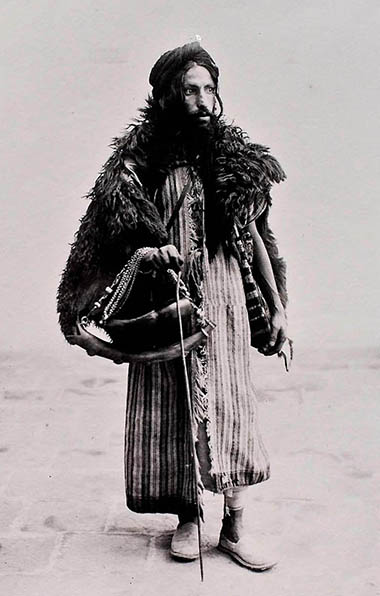
Dervish; photograph by Sevryugin Anton (1830 – 1933),
the official photographer of the Imperial Court of Iran
In the early 19th century there was a florescence of Protestant missionary interest in saving Muslim, Jewish and other kinds of Christian souls in the Middle East. This thread continues excerpts from one of the earliest accounts from the 19th century, that of Joseph Wolff (1795-1862), a convert from Judaism to Christianity. In 1837 he published a diary of his travels. Like a number of Christians visiting the Muslim world, Wolff is more impressed by Muslim sobriety and devotion in their ritual than he is by the Christians he sees:

There is also an intriguing encounter between the Christian missionary and a Kurdish Muslim dervish:
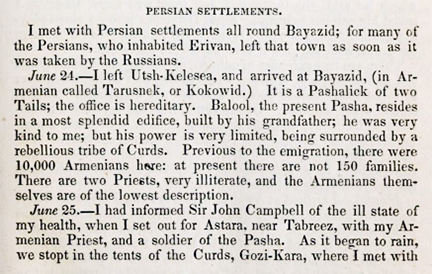
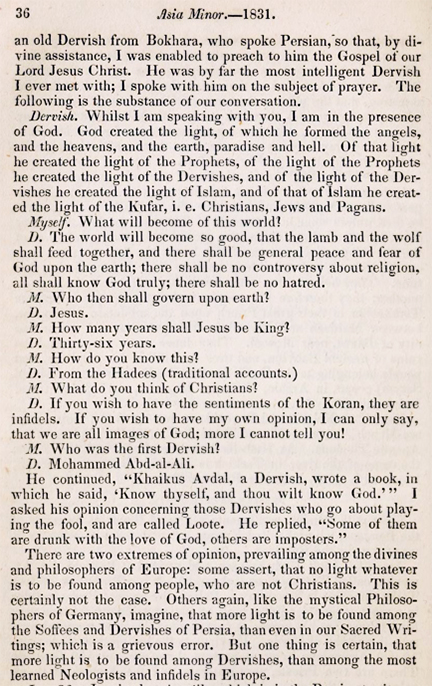
Chalk one up for the Kurdish dervish over the atheists of Europe.
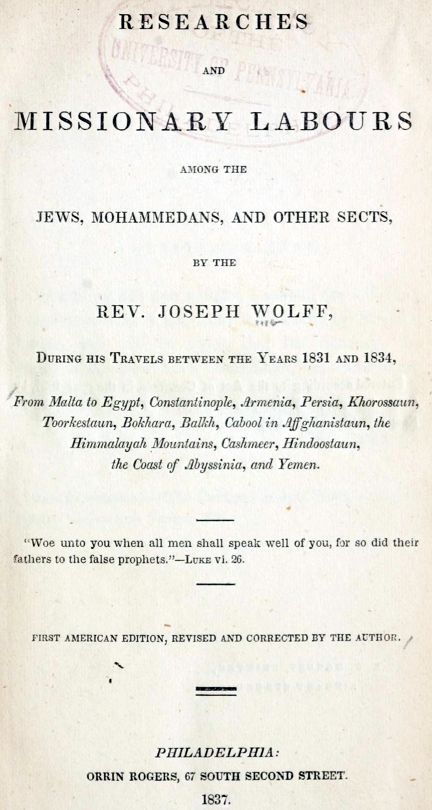
In the early 19th century there was a florescence of Protestant missionary interest in saving Muslim, Jewish and other kinds of Christian souls in the Middle East. This thread continues excerpts from one of the earliest accounts from the 19th century, that of Joseph Wolff (1795-1862), a convert from Judaism to Christianity. In 1837 he published a diary of his travels. Here are the passages related to a brief stop in several of Yemen’s ports:
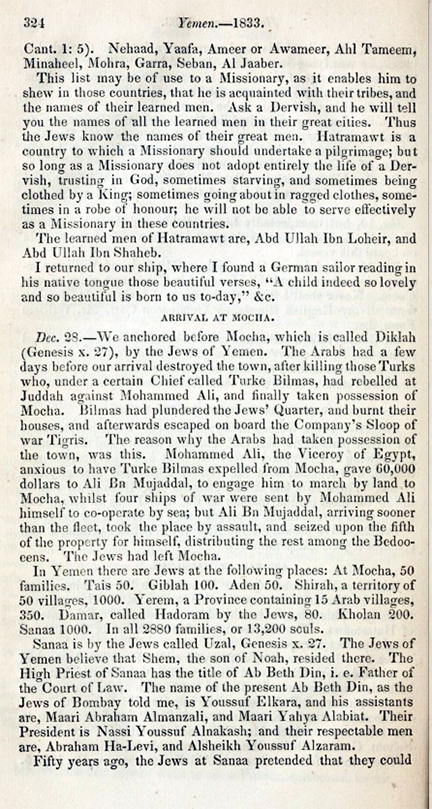
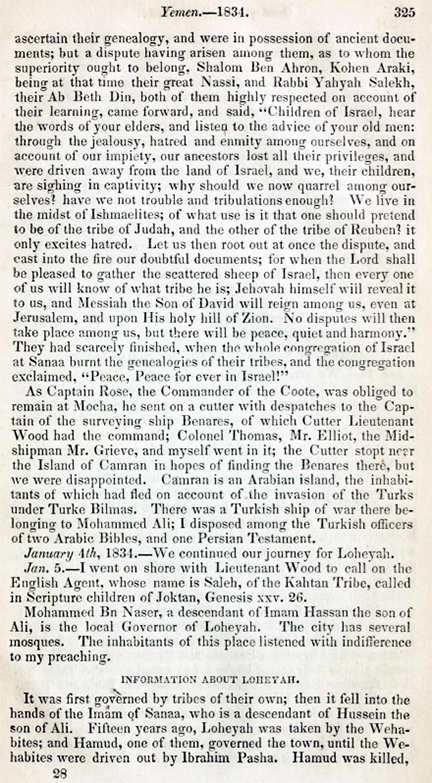

to be continued…
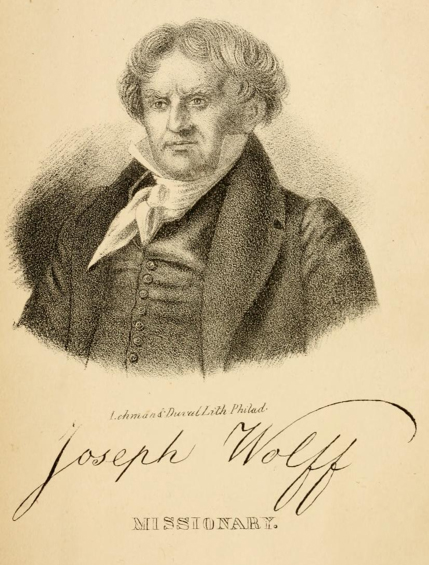
Tabsir Redux…
In the early 19th century there was a florescence of Protestant missionary interest in saving Muslim, Jewish and other kinds of Christian souls in the Middle East. One of the earliest accounts from the 19th century is that of Joseph Wolff (1795-1862), a convert from Judaism to Christianity. His missionary travels began in 1821 and he also went in search of the “lost tribes” of Israel. In 1837 he published a diary of his travels. This is a fascinating book to read, once one gets by the evangelistic fervor. He was considered by fellow missionaries to be somewhat of an “eccentric,” as he acknowledges in the frontispiece to his travels.
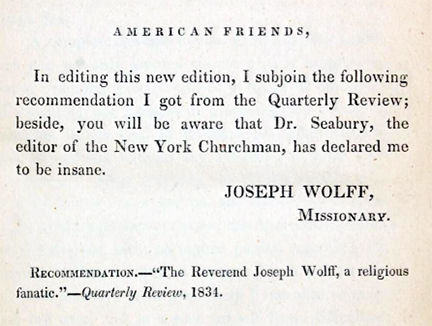
Here is how he begins his book…
Continue reading A Wolff in Shepherd’s Clothing #1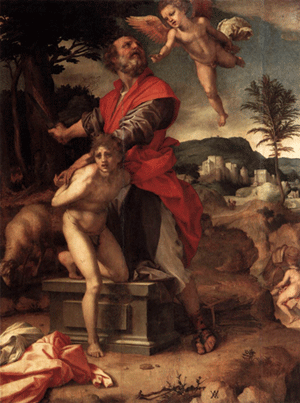
The Sacrifice of Abraham, by Andrea del Sarto, ca. 1527-1528
A fable, dedicated to Mark Twain and all who really understand what it means to suffer
Abraham was sitting in his tent door near the oaks of Mamre. He was getting on in years and his son Ishmael would soon have to take over the family herds. So it was time to think about buying a burial site, perhaps the cave that Hittite had offered over near Hebron. Then he lifted up his eyes and three men stood before him. And though he did not realize it at the time, these were angels sent from God.
“Abraham,” said one of the angels, “God wants you to know what is going to happen to your descendants over the next three or four thousand years. So we are here to tell you. Are you sitting down?” Abraham was used to the flamboyance of this One God, so he made sure he stayed close to the ground.
“First of all,” said another angel, “your wife Sarah is going to have a son. I know she is a hundred years old and will probably think this is some kind of joke, but let me tell you that God doesn’t fool around when it comes to sex. You have to call this son “Isaac” and then just when you think things are going alright, God is going to ask you to take Isaac up on a mountain and kill him as a sacrifice.”
Abraham decided to keep quiet. Maybe there was more. Continue reading If only Abraham had known …

The New York Review of Books has an interesting review of three recent books on the archaeology and filmic versions of ancient Egypt.

There were many books written by Christian missionaries and clergy during the 19th century. While the text itself has long since been outdated, the engravings are still fascinating to look at. The illustrations here are from an 1875 book of Bible Manners and Customs by the Methodist-Episcopal preacher James M. Freeman. It is available for free on archive.org. But there is also a brand new edition currently in press for 2021 and already noted on Amazon. I attach several of the images below the book title.








Yesterday there was an extravaganza parade in Cairo parading the embalmed remains of 22 ancient Egyptian pharaohs to their new “eternal” resting place in the National Museum of Egyptian Civilization. You can and should watch the entire show, which you can do here. It featured a major musical composition of Mahleresque length, at times rivaling the soundtrack of Star Wars, but with a lot of drumming to match the pace of the parade. The parade included Egyptian women, shown above, and men dressed in “pharaonic” costume (with a Hollywoodish make-over), men in chariots and coffinesque vehicles carrying the pharaohs and their consorts. On the screen in the auditorium for the elite guests of President el-Sisi, there were scenes of several monuments and dance routines that might best be called an Orient Side Story. You can read all about it here.

The star of the show was the modern day would-be Ramses, President Abdel Fattah el-Sisi, who was front and center before the staged event. He sat like a stoic behind a Covid mask for well over an hour; then as the caravan of his ancestral rulers neared the new museum, there is a scene of several minutes as he walks through the corridors, a smile on his face, to greet the mummies. The reason for spending a large amount of government funds on such a show is obvious: Egypt is desperate to revive the tourism industry. The choreographed show happened at night, with what appear to be few spectators, but the real audience was for those abroad. As one of the speakers said, the heritage of Egypt is the heritage of the entire world.
Presenting Egypt to the world of potential tourists is at the same time sending a message that Egypt is not a dangerous Islamic haven for terrorists, certainly not for the Muslim Brothers after el-Sisi took power. The heritage celebrated in the show was not Islamic, although the theme of ancient Egyptian faith and justice harmonizes with the positive view of Islam the tourism industry must push. The orchestra looked like any classical music orchestra in the world. The close-ups of the players showed most women performers without hijab, as was also the case for the main singers on stage. The only dress visible in the show was what would be seen as modern Western attire, elaborate stage dresses for the singers and supposedly ancient Egyptian costume.
I enjoyed the pomp and pop-cultured kitsch, and the music was enthusiastic in the best way. It was indeed a celebration of Egypt, with an echo of the extravaganza of 1912, when the opera Aida was performed at the foot of the Pyramid of Cheops. I do not know of a recording from that performance, but here is Caruso’s rendition of “Celeste Aida” from 1908. I have no idea how many people watched that performance, but I suspect it was the better-off beys and not the peasant farmers. By the way, Verdi’s Aida was was commissioned by the Khedivial Opera House in Cairo and had its premiere on 24 December 1871.

The idea of the ruler overseeing a parade is a remake of ancient Egyptian rituals, where it was important to renew the divinity of the ruler, a historic note that perhaps made el-Sisi smile in the corridor. After all, wouldn’t all Egyptian peasants have adored their pharaoh, so happy to spend years lugging stone after stone to erect a monstrous resting place for their master? It’s a wonder why the Hebrews didn’t stay and keep making mudbricks instead of almost drowning in the Red Sea and ending up in the desert for 40 years…

Autocrats, no matter whether they are benevolent or not, love nationalistic parades. In 1971 the Shah of Iran celebrated the founding of the Achaemened by Cyrus the Great 2,500 years earlier. The Soviet Union and China love their military parades and Donald Trump tried to pull one off for Washington DC off when he was in power.

As someone who grew up wanting to be a Biblical Archaeologist and who started a graduate career planning to be a Near Eastern archaeologist, I have long been under the spell of the ancient Egyptians. My visit to the Cheops Pyramid when it was still possible to shimmy up the narrow passage to an empty tomb room and my walk around the ruins of Luxor left memories that continue to this day. If you have not seen these wonders, you should plan to visit Egypt at some point. But Egypt also hosts incredible monuments and historical objects from the Islamic era, especially the early Mamluk period. The entire history of Egypt is worthy of a parade, but only as long as we remember that poverty is still endemic in the country, the ills that led to the Arab Spring have not disappeared, and democracy has taken a back seat.